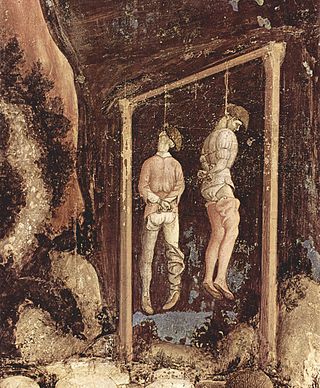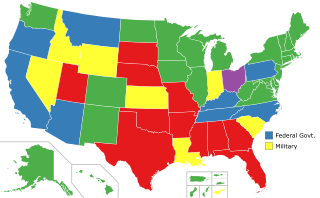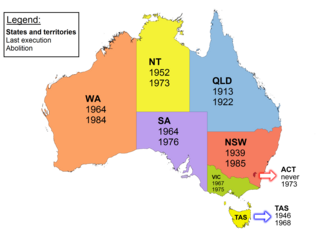Related Research Articles
Capital punishment, also known as the death penalty and formerly called judicial homicide, is the state-sanctioned practice of killing a person as a punishment for a crime, usually following an authorised, rule-governed process to conclude that the person is responsible for violating norms that warrant said punishment. The sentence ordering that an offender be punished in such a manner is known as a death sentence, and the act of carrying out the sentence is known as an execution. A prisoner who has been sentenced to death and awaits execution is condemned and is commonly referred to as being "on death row". Etymologically, the term capital refers to execution by beheading, but executions are carried out by many methods, including hanging, shooting, lethal injection, stoning, electrocution, and gassing.

Hanging is killing a person by suspending them from the neck with a noose or ligature. Hanging has been a common method of capital punishment since the Middle Ages, and is the primary execution method in numerous countries and regions. The first known account of execution by hanging is in Homer's Odyssey. Hanging is also a method of suicide.

Capital punishment in the United Kingdom predates the formation of the UK, having been used within the British Isles from ancient times until the second half of the 20th century. The last executions in the United Kingdom were by hanging, and took place in 1964; capital punishment for murder was suspended in 1965 and finally abolished in 1969. Although unused, the death penalty remained a legally defined punishment for certain offences such as treason until it was completely abolished in 1998; the last execution for treason took place in 1946. In 2004 the 13th Protocol to the European Convention on Human Rights became binding on the United Kingdom; it prohibits the restoration of the death penalty as long as the UK is a party to the convention.

In the United States, capital punishment is a legal penalty throughout the country at the federal level, in 27 states, and in American Samoa. It is also a legal penalty for some military offenses. Capital punishment has been abolished in 23 states and in the federal capital, Washington, D.C. It is usually applied for only the most serious crimes, such as aggravated murder. Although it is a legal penalty in 27 states, 20 states have the ability to execute death sentences, with the other seven, as well as the federal government, being subject to different types of moratoriums.
The U.S. state of Washington enforced capital punishment until the state's capital punishment statute was declared null and void and abolished in practice by a state Supreme Court ruling on October 11, 2018. The court ruled that it was unconstitutional as applied due to racial bias however it did not render the wider institution of capital punishment unconstitutional and rather required the statute to be amended to eliminate racial biases. From 1904 to 2010, 78 people were executed by the state; the last was Cal Coburn Brown on September 10, 2010. In April 2023, Governor Jay Inslee signed SB5087 which formally abolished capital punishment in Washington State and removed provisions for capital punishment from state law.
Capital punishment in Canada dates back to Canada's earliest history, including its period as a French colony and, after 1763, its time as a British colony. From 1867 to the elimination of the death penalty for murder on July 26, 1976, 1,481 people had been sentenced to death, and 710 had been executed. Of those executed, 697 were men and 13 women. The only method used in Canada for capital punishment of civilians after the end of the French regime was hanging. The last execution in Canada was the double hanging of Arthur Lucas and Ronald Turpin on December 11, 1962, at Toronto's Don Jail. The National Defence Act prescribed the death penalty for certain military offences until 1999, although no military executions had been carried out since 1946.
Capital punishment was abolished in 2019 in New Hampshire for persons convicted of capital murder. It remains a legal penalty for crimes committed prior to May 30, 2019.

Capital punishment – the process of sentencing convicted offenders to death for the most serious crimes and carrying out that sentence, as ordered by a legal system – first appeared in New Zealand in a codified form when New Zealand became a British colony in 1840. It was first carried out with a public hanging in Victoria Street, Auckland in 1842, while the last execution occurred in 1957 at Mount Eden Prison, also in Auckland. In total, 85 people have been lawfully executed in New Zealand.

Capital punishment is a legal penalty in Japan. In practice, it is applied only for aggravated murder, but the current Penal Code and several laws list 14 capital crimes, including conspiracy to commit civil war; conspiracy with a foreign power to provoke war against Japan; murder; obstruction of the operation of railroads, ships, or airplanes resulting in the death of the victim; poisoning of the water supply resulting in the death of the victim; intentional flooding; use of a bomb; and arson of a dwelling; all resulting in the death of the victim. Executions are carried out by long drop hanging, and take place at one of the seven execution chambers located in major cities across the country.
Capital punishment in Hong Kong was formally abolished on 23 April 1993 by virtue of the Crimes (Amendment) Ordinance 1993. Before then, capital punishment was the usual sentence given since the establishment of the Crown Colony of Hong Kong for offences such as murder, kidnapping ending in death, and piracy.
Capital punishment for murder was abolished in Malta in 1971. It continued to be part of the country's military code until it was fully abolished on 21 March 2000. Malta is a signatory of the Second Optional Protocol to the International Covenant on Civil and Political Rights that commits it to abolition of the death penalty within its borders. Malta has also ratified protocol 13 to the European Convention on Human Rights, that bans the death penalty in all circumstances.

Capital punishment in Australia was a form of punishment in Australia that has been abolished in all jurisdictions. Queensland abolished the death penalty in 1922. Tasmania did the same in 1968. The Commonwealth abolished the death penalty in 1973, with application also in the Australian Capital Territory and the Northern Territory. Victoria did so in 1975, South Australia in 1976, and Western Australia in 1984. New South Wales abolished the death penalty for murder in 1955, and for all crimes in 1985. In 2010, the Commonwealth Parliament passed legislation prohibiting the re-establishment of capital punishment by any state or territory. Australian law prohibits the extradition or deportation of a prisoner to another jurisdiction if they could be sentenced to death for any crime.
Capital punishment is a legal penalty in Malaysian law.
Capital punishment in Connecticut formerly existed as an available sanction for a criminal defendant upon conviction for the commission of a capital offense. Since the 1976 United States Supreme Court decision in Gregg v. Georgia until Connecticut repealed capital punishment in 2012, Connecticut had only executed one person, Michael Bruce Ross in 2005. Initially, the 2012 law allowed executions to proceed for those still on death row and convicted under the previous law, but on August 13, 2015, the Connecticut Supreme Court ruled that applying the death penalty only for past cases was unconstitutional.
Rhode Island was one of the earliest states in the United States to abolish capital punishment, having abolished it for all crimes in 1852. The death penalty was reintroduced in 1872, but it was never carried out before being abolished again in 1984. Of all the states, Rhode Island has had the longest period with no executions, none having taken place since 1845.
Capital punishment was abolished in Colorado in 2020. It was legal from 1974 until 2020 prior to it being abolished in all future cases.
Capital punishment is legal in Tonga, but has not been imposed since 1982. The country's lack of executions puts it into the category of a state abolitionist in practice, where it retains the death penalty in law but has had a formal or informal moratorium for at least ten years. Tonga's low rate of murder convictions forms part of the reason for the lack of executions, as well as its courts’ apparent unwillingness to impose the penalty unless it appears absolutely necessary to do so.
Hanging has been practiced legally in the United States of America from before the nation's birth, up to 1972 when the United States Supreme Court found capital punishment to be in violation of the Eighth Amendment to the United States Constitution. Four years later, the Supreme Court overturned its previous ruling, and in 1976, capital punishment was again legalized in the United States. As of 2023, only New Hampshire has a law specifying hanging as an available secondary method of execution, and even then only for the one remaining capital punishment sentence in the state.
Capital punishment has been abolished in Iowa since 1965. Forty-five men were executed by hanging in Iowa between 1834 and 1963 for crimes including murder, rape, and robbery.
Capital punishment in Hawaii ended in 1957 when it was still an organized incorporated territory of the United States. About 75 people were executed by the government, all for the crime of murder, and all by hanging. Additionally during and after World War II, at least seven U.S. servicemen were executed by the United States Armed Forces by order of a general court martial.
References
- 1 2 Bill Pesch (August 23, 2015). "Capital punishment in Guam". Pacific Daily News . Retrieved February 7, 2021.